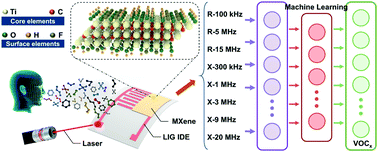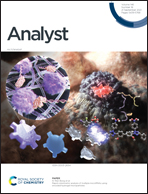A flexible virtual sensor array based on laser-induced graphene and MXene for detecting volatile organic compounds in human breath†
Abstract
Detecting volatile organic compounds (VOCs) in human breath is critical for the early diagnosis of diseases. Good selectivity of VOC sensors is crucial for the accurate analysis of VOC biomarkers in human breath, which consists of more than 200 types of VOCs. In this paper, a flexible virtual sensor array (FVSA) was proposed based on a sensing layer of MXene and laser-induced graphene interdigital electrodes (LIG-IDEs) for detecting VOCs in exhaled human breath. The fabrication of LIG-IDEs avoids the costly and complicated procedures required for the preparation of traditional IDEs. The FVSA's responses of multiple parameters help build a unique fingerprint for each VOC, without a need for changing the temperature of the sensing element, which is commonly used in the VSA of semiconductor VOC sensors. Based on machine learning algorithms, we have achieved highly precise recognition of different VOCs and mixtures and accurate prediction (accuracy of 89.1%) of the objective VOC's concentration in variable backgrounds using this proposed FVSA. Moreover, a blind analysis validates the capacity of the FVSA to identify alcohol content in human breath with an accuracy of 88.9% using breath samples from volunteers before and after alcohol consumption. These results show that the proposed FVSA is promising for the detection of VOC biomarkers in human exhaled breath and early diagnosis of diseases.



 Please wait while we load your content...
Please wait while we load your content...